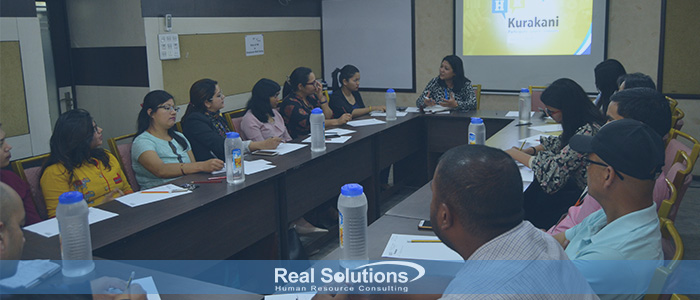
Role of HR in Employee Well-being, Discussed at the 78th HR Kurakani
Category: HR Kurakani | Date: May 1, 2019, 3:30 p.m. | Total Views: 1609
Real Solutions Pvt. Ltd. conducted its 78th HR Kurakani on April 24, 2019 on the topic “Role of HR in Employee Well-being”. Employee well-being has always been a key issue that companies are striving to address to ensure that the employees remain happy and motivated at work. For the discussion program, HR professionals from various industries gathered at Real Solutions Pvt. Ltd. and shared what employee well-being practices they have adopted along with the challenges and probable solutions.
Employees being the biggest asset for every organization their well-being is of utmost relevance when it comes to ensuring increased productivity and operational efficiency. During the work hour employees have to handle immense pressure and tight deadlines which hamper the quality of their life and also affect their body in many ways. HR, being the key facilitator in the organization, has to ensure that the employee is fit and fine, both mentally and physically.
HR professional from diverse organizations shared their experiences regarding the employee well-being programs at their workplace. Some of the best practice’s programs are as follows:
- Flexible working hours
- Power Nap
- Healthy Office Snacks
- Insurance
- Training and Development
- Incentives and Rewards
- Yoga and Fitness Classes
- Tea with HR
- Dietician session at the office
These practices were mostly very common to one another. However, some unique modifications were also observed. The most notable one being the inclusion of family in these practices. A great practice shared by one of the practitioners was inviting an employee’s family members in the organization, to see the workplace, meet & greet everyone in the organization and share a healthy lunch with everyone in the organization. It is one of the easiest and most effective ways an organization can get a sense of whether employees feel proud/happy of their workspaces and a connection to the organization by seeing whether employees bring in their family members when and if allowed.
Challenges to Employee Well-being
Here Professional agreed that Employee Well-being programs not only potentially improve employee morale, but also decreases absenteeism and even reduces health care costs of an employee. However, starting and maintaining a program of this type isn't always easy. Often, many challenges stand in the way of program success. The most common challenges include:
Creating a culture that supports well-being:
Most workplaces are already doing lot of things to promote well-being, but these aren’t always coordinated. Changing culture takes time, and a planned approach is more practical than one-shot events.
Lack of Interest:
Employees may show a lack of interest or follow-through when it comes to well-being programs. They may not want to participate in the activities or may not even know about all of the well-being options available to them. It’s important to market well-being options well to the employees and motivate them to participate.
Creating targeted and meaningful activities
Well-being means something different to each of us, which can be why it feels like a challenge to get your team involved with activities. It is not going to please everyone, still getting the team involved with assessments and feeding back your findings will help them feel valued and drive engagement. There are lots of different tools that can be used, from Employee Satisfaction Surveys and audits. A good old-fashioned suggestion box can be a non-threatening way of getting ideas from the employees.
Inadequate Funds
Starting and maintaining a great well-being program requires funding from the organization budget. When a business refuses to allocate any funds to a workplace well-being program, it is hard for the program to be successful. To ensure well-being program has sufficient funding, you will need to make sure that company leadership buys-in to the program. It needs to be supported by upper level staff to ensure there are people in powerful places advocating for the necessary funding.
Arriving to a conclusion that employee well-being has potential of great benefits to an employee and the organization, it was then discussed how Labour Act 2018 has also addressed issues of health and safety of employees at work. The participants at the Kurakani also shared the health and safety practices employed in their organizations. A number of practices were observed, and amongst them, it was discovered that forming a Health and Safety Committee at the workplace can be a great way to encourage safe work practices amongst employees.
The Kurakani then officially ended with a vote of thanks. The 78th HR Kurakani helped highlight numerous problems still faced by organizations in Nepal in terms of Employee Well-being. It was also fruitful in providing numerous insights to overcome at least some of these problems, the implementation of which could provide a healthier and happier work experience for employees.



